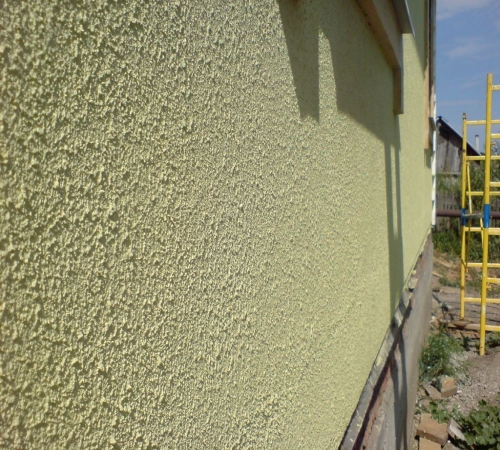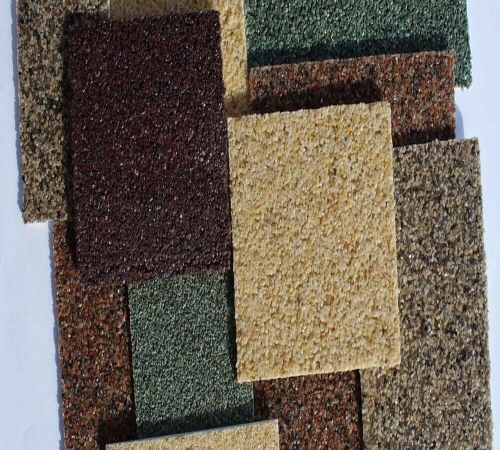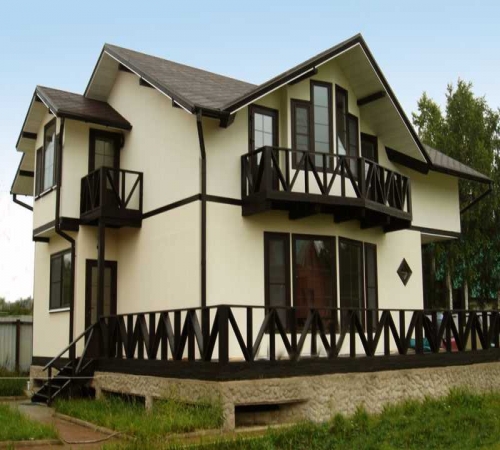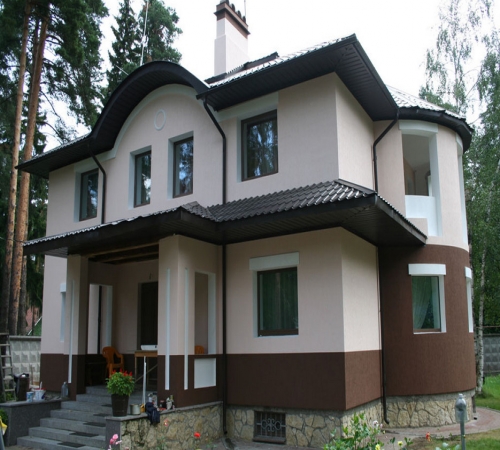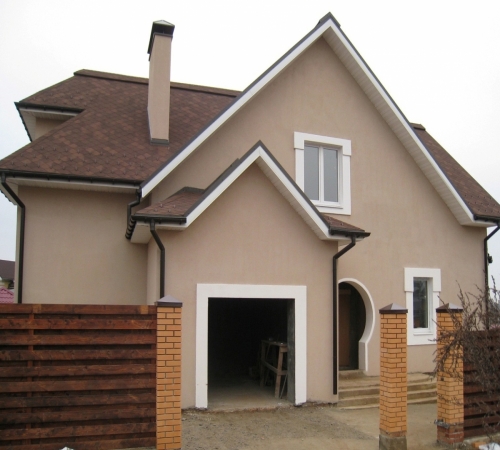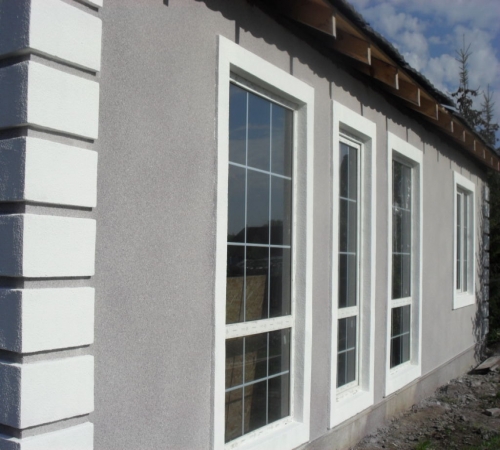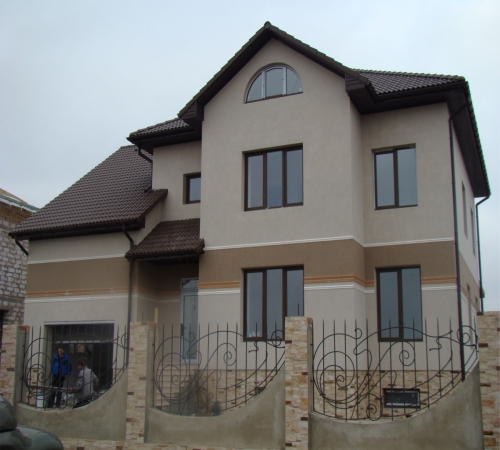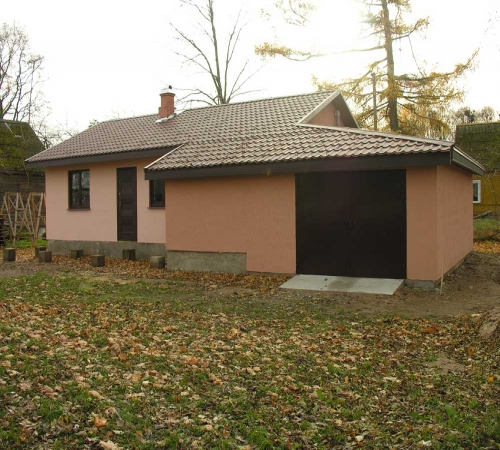Not so long ago in your apartment you made repairs and proudly showed guests ...
|
|
The duration of the operation of the laminate is from 10 to 20 years, depending on its ... |
To build a building from a cinder block yourself is quite real even an inexperienced newcomer ... |
Facade plaster for external work: types, features and application technology. Instructions for working with facade plaster
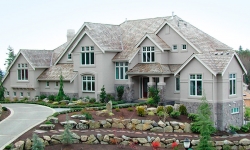
The decoration of the facade is a very important process that determines the appearance of the building and its compliance with the environment. Several options for facade plasters are distinguished, which differ in composition, texture and type of binder. We will talk about the advantages, technology and features of each of them further.
Table of contents:
- Advantages of facade plaster
- Types of facade plaster and their characteristic
- Mineral -type facade installation technology
- Applying silicone type facade plaster
- Features of the facade plaster of acrylic type
- Facade plaster video
Advantages of facade plaster
Before moving on to the advantages of using facade plaster, we will determine the functional features of the facade:
- external finish protects the building from negative atmospheric and mechanical exposure;
- gives the building an attractive appearance and the desired texture.
For tinting and adjusting the color of the plaster, a dye is added to it. This finishing material has a wide color scheme.
Among the main advantages of facade plaster, we note:
- High adhesion with the base, elasticity and quality composition.
- The possibility of long -term storage, in a non -divorced form.
- Resistance before mechanical influences, moisture, temperature changes, ultraviolet radiation.
- Environmental safety - material during operation does not emit toxic substances.
- It differs in minimal absorption of dirt, easily washed. Some options for plaster are self -cleaned.
- Vapor proceedings - provides comfortable conditions for living in the room. The coating passes the air, creating natural ventilation.
- The ease of application and a variety of options for plasters in texture, composition, color, application method.
In the ratio from the compositions of the plasters, options are distinguished:
- mineral;
- silicate;
- acrylic;
- silicone origin.
The first option consists of cement with the addition of polymer inclusions that improve clutch and give the composition of greater elasticity. Silicate plastering mass contains fiberglass inclusions and plasticizers, has good operational characteristics.
Acrylic -based plaster contains acrylic resin, and silicone - silicone. If the wall is made of natural material, then the plastering compounds of mineral, silicate or silicone origin are used to finish it. These compositions have high vapor permeability, interact well with insulation in the form of mineral wool. For polystyrene insulation systems, acrylic -based plaster options are suitable.
External plaster for an acrylic basis facade is characterized by good characteristics and the highest life. Mineral plaster is the cheapest, but also in operation - the least durable. The average resistance to the influence of the external environment differs in plaster with silicate and silicone composition.
The structure of the plaster also determines the duration of its operation. The greater smoothness the surface differs, the faster it is covered with cracks. Therefore, we recommend that you prefer rough surfaces.
The resistance of the plaster before burning is directly determined by the saturation of tones. The lighter the tone of plaster, the better it retains color indicators.
Types of facade plaster and their characteristic
Check out more with the main types of plaster for external decoration of buildings. First of all, we will consider the main types of plaster in relation to the composition.
Plaster with acrylic binders - is characterized by good vapor peripation. This composition, with a lack of moisture in the room, gives it, and with excess - absorbs, thereby maintaining optimal microclimatic conditions. This is provided by the presence in the dispersion of resin on a synthetic basis. Among the additional advantages of this composition, we note: good resistance to temperature fluctuations, elasticity, resistance to microorganisms: fungus and mold.
Despite this, acrylic plaster has certain shortcomings, namely:
- easily polluted, as it does not have electrostatism;
- It differs in high cost.
Facade plaster in silicate origin also has high vapor permeability. This coating has a wide sphere of application, as it has neutral electrical static. The main element of this plaster is potassium liquid glass. The coating is not prone to pollution, tolerates moisture well, temperature fluctuations, ultraviolet radiation does not crack.
Mineral plaster - one of the most popular finishing materials, consists of cement with additional polymer substances. The material is distinguished by the highest strength characteristics, affordable cost and wide use. In addition, we note the following advantages of a mineral basis:
- high level of vapor permeability - they do not leave condensate on the walls, regulate the microclimatic conditions indoors;
- high pH provides the resistance of the plaster before the appearance of the fungus and mold;
- frost resistance, resistance before precipitation and ultraviolet radiation;
- Fire safety - the material is not prone to combustion;
- Environmental safety - in the composition of plaster there are no toxic substances that are harmful to health;
- Lightness of washing - to clean the walls use ordinary water or additional detergents;
- After drying, it does not lend itself to shrinkage and does not crack, subject to the technology of applying plaster to the wall.
However, mineral plaster is distinguished by a limited color scheme, although after drying, it is painted with facade paints in almost any color. The process of applying plaster requires compliance with strict technological norms and dosages, otherwise, the coating will not have the necessary strength.
The duration of the operation of the coating is about ten years, the material is sensitive to vibrations, and is cracking under their influence.
Silicone plaster is characterized by maximum durability, good dirt -repellent abilities and resistance before atmospheric precipitation. The walls on which this finishing material is applied are not prone to the formation of mold or fungus. Silicone plaster is a universal composition that combined all the advantages of plasters on a mineral and acrylic basis:
- excellent moisture repellent abilities;
- good vapor permeable characteristics;
- resistance in front of the fungus, mold and other microorganisms;
- increased resistance before temperature fluctuations;
- the absence of not only cracks, but also microcracks on the facade part of the building;
- high level of elasticity;
- High -strength adhesion with any coatings.
Several texture options for silicone plaster are distinguished:
- bark beetle - used for decoration of the facade, insulated with polystyrene, additionally reinforced with fiberglass;
- lamb - is rough;
- Stucked stone type - is characterized by a more smooth texture and add crumbs made of stone as a filler;
- The plaster on the Venetian basis - contains a crumb of marble, in appearance similar to a polished marble coating.
Mineral -type facade installation technology
Before the application of mineral plaster - align the base. If necessary, delete the old finish, get rid of cracks and other surface defects. Remove fat spots and rust. Further, the surface is covered with an acrylic -based primer, this composition has a powerful antiseptic effect and improves the clutch of the wall with further finishing material.
At the next stage, the preparation of a plaster solution is performed. Pre -read the instructions that indicate the recommendations for the preparation of the composition. Two methods of applying plaster are distinguished:
- manual;
- mechanical.
The first implies the use of a metal spatula, and the second is based on the use of special pumping equipment. The optimum air temperature for this kind of work is from +12 to +24 degrees.
The solution of the equipment greatly simplifies the process of applying the plaster, evenly distributing it on the surface. For use, follow the instructions below:
- Prepare the tool for work, pick up the gun and turn sideways to the wall.
- Install the pump in a container with a plaster solution. Open the valve and wait for the plaster to feed on the wall.
- Apply the composition first from the bottom up, and then from right to left. First, fill out small irregularities and hollows.
- Upon completion of the work, close the valve, then with the help of the rule, degre up the surface.
Manual application of plaster is a more complex process, since the solution is applied to the surface with a spatula. At the same time, it is important to choose the optimal thickness of the layer. After applying the solution, wait half an hour to set it. Next, the process of manufacturing the texture of the plaster using a special grater follows.
Use decorative plaster from one manufacturer and preferably one batch. Perform work using protection tools in the form of gloves, protective glasses. After applying plaster, at least three days, protect it from excessive solar radiation, wind and moisture.
Applying silicone type facade plaster
At the initial stage of working with silicone facade plaster with your own hands, carefully prepare the surface. In the presence of seams between the masonry material, they are sewn up to at least one centimeter. To improve adhesion to the surface, seams of a deformation nature are equipped on the facade. Next, the surface is exhausted and moistened.
At the next stage, a stucco mixture is prepared, the optimal time for using a plaster solution is 1-2 hours. Further, the composition loses the strength characteristics.
The following is the process of applying plaster spray. For these purposes, you will need to have a tool for installing facade plaster and certain skills in working with it. The throws should be sharp and strong in order for the solution to stick well to the surface.
Check out recommendations for working with plaster:
- It is forbidden to apply plaster on the recently constructed walls, since when shrinking there is a risk of cracking it;
- The gypsum solution is not applied to the concrete base, since in the future such plaster is swollen and falling off, first the wall is finished with plaster with lime content, and then with gypsum;
- The grout of the plaster is performed a few days after its application, the plaster at the same time becomes stiff, but does not completely set;
- The thickness of one layer of plaster composition should not exceed two centimeters.
To grout the plaster, use a special grater made of wood or aluminum, on top of which foam is glued. In a circular motion, press it to the surface, wiping it with a solution.
Features of the facade plaster of acrylic type
To apply a composition on an acrylic basis, a regular spatula is used. This plaster is characterized by the highest drying rate. Therefore, before applying the composition, it is recommended to level the surface as thoroughly as possible. The processing of the selected fragment is performed quickly and continuously. Otherwise, there is a possibility of joints, irregularities and differences in color.
Pre -divided the wall into several areas, into which a plaster solution is applied in stages. If necessary, during the break, before applying the plaster, moisten the boundaries of the previous section with water.
It is possible to apply acrylic plaster using special equipment in the form of a machine for spraying. Until the composition completely dry, protect it from atmospheric precipitation.
Keep in mind that the color of dried acrylic plaster is always darker than liquid. Therefore, the facade darkens over time after drying. For the longest period of operation of acrylic plaster, apply it to a pre -prepared surface.
Clean the facade of the old plaster or paint, get rid of fat spots or corrosion, warm the surface. The thickness of the applied layer should not exceed three millimeters. The setting time of the composition is 25 minutes, and complete drying from 10 hours. To give the structure, the walls use special rollers. To wash acrylic plaster, it is enough to use warm water with a sponge.

